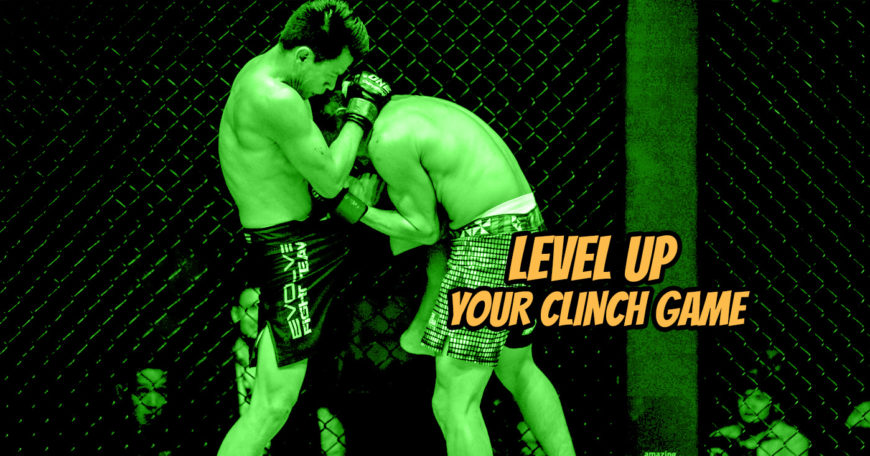The clinch is a unique skill set belonging to muay Thai, that helps differentiate it from other striking sports, like kickboxing. It is most easily described as a form of stand up wrestling. To outsiders, it may look like “hugging”, but that is too simplistic. The clinch is a very technical and strategic area of Thai boxing that includes the use of elbows, knees, sweeps and throws. In Thailand, although not always the case, it is weighted heavily in fights and performance in this area can be the difference between winning and losing.
The clinch only occurs at close range. This range is too close for punches or kicks. Both fighters should have a hold of one another, using the arms to control their opponent, and create openings for point scoring. Often chest to chest, fighters will manoeuvre the other, not by sheer force, but by feeling out when the other fighter is off balance. Being off balance makes it easier to be successfully swept or thrown onto the floor, which scores massive points for the aggressor, and entertains the spectators.
The Thais spend many hours practicing, some even do it with their eyes closed, to get a “feel” for it, recognising and anticipating body movements and how they can be exploited. Few Farangs (foreigners) can measure up to the seemingly endless knowledge the Thais have in this particular area. Even the best Western coaches only know about 60-80% of what those in Thailand do. This is why it is so important to develop strength in the most crucial areas if you want to level up your clinch game.
Here are the key areas to focus on when looking to develop your clinch strength and competency:
The Wrists:
It is a misconception that improving your grip strength directly correlates to an increase in clinch strength. The vast majority of competitive clinching will be done with fully enclosed gloves. Amateurs often start fighting in 16oz or 14oz gloves and these are not very flexible. While professional fights usually involve using 8oz gloves, allowing more range of motion, it is still quite restrictive on the hands themselves. Additionally, whether in practice or a professional setting, clasping of the hands or gloves is illegal in the sport. This is exactly the reason why we must develop our wrist strength instead. It is actually the wrist, not the fingers or hands, that are used to execute the necessary locks and turns.
Pull-ups are one of the simplest and most effective ways to improve wrist strength. While they can be a challenging exercise for anyone starting out, they are also a staple in a fighter’s conditioning program and should likewise be treated as an essential addition for anyone looking to up their clinch strength. It is advised to perform both regular pull-ups and false grip pull-ups. Both will strengthen the back, core and forearms but the latter will place more emphasis on the wrists vs the hands.
Pull-Up Progressions:
Level 1: For either variation, begin with a hang. This involves simply hanging from a pull-up bar or pair of rings. This is called a ‘dead hang’. Once you can dead hang for at least 20 seconds, move on to a ‘flex hang’. For a flex hang, you will hold yourself at the top of the movement, with your chin above bar level. Again, work yourself up to at least 20 seconds before moving onto the next progression.
Level 2: Assisted pull-ups. Pull-ups can be assisted by a machine, a resistance band, or by pushing off a bench below you.
Level 3: Finally, attempt an unassisted pull-up. Even if you can only manage a few, perform 3 sets to failure.
To see exactly how it’s done, check out the following video from expert strength and conditioning coach, Don Heatrick, who specialises in building combat sport athletes.
The Neck:
The neck is another area that requires serious strength to win in the clinch. To give your opponent control of your head can be very dangerous. This is because where the head goes, the body follows. When clinching, your partner or opponent will usually have at least one hand on the back of your head. From here, they will try to maneuver your head to gain dominance and control over you. Even single-handed grips can be used to pull you into knee strikes or pull you over the leg for a dump. However, when your opponent gains a dominant hold (both hands on the inside) on the back of your head, they can use this position to pull your head down towards the ground. This is unfavourably viewed by the judges, for a start, but also poses a risk of being kneed in the head. Having good neck strength can prevent this from happening.
More generally, decent neck strength often reduces the dominance an opponent can have over you and helps minimize fatigue and frustration in the clinch.
There are a multitude of exercises available to develop neck strength. There is also a decent variety of equipment available depending on your specific needs.
Muay Thai champion, Jonny Betts, provides 4 simple exercises in the following video. Start with bodyweight only, before progressing to weighted exercises.
The Back:
The back is another major muscle group that’s heavily relied on in the clinch. The two major muscles that make up the back, are the trapezius and the latissimus dorsi, which sit above and below the shoulder muscles respectively. Both are worked during pull-ups, which we covered earlier, but the back benefits from being trained in multiple ranges of motion.
Including rows to the arsenal will help to develop your pulling power, which, of course, is a must when clinching. When we rely on the arms alone to control our opponent, our biceps, triceps and forearms can exhaust quickly. They are small muscles compared to the back. However, when we engage our lats in the locks and pulls, we access a much more powerful body part that is harder to fatigue.
This back circuit from Funk Roberts is an excellent tutorial if you have access to a gym or equipment. If, like many of us, you are still working out from home, resistance bands can simulate many of these movements and are particularly suitable if you are new to lifting. Check out the following comprehensive resistance band workout by Zeus Fitness.
The Core:
Technically, the core includes the back, which we’ve just covered, but the core also includes the abdominals (among other muscles) which we will focus on here. The abdominals are made up of the transverse abdominis ( deepest layer), rectus abdominis (top layer), and the external obliques ( on the sides).
Overall core work should always be a part of a fighters conditioning program. Exercises such as planks, hollow holds, and farmers walks all sufficiently challenge the core and are easy to do whether or not you have access to gym equipment.
There is an abundance of exercises that target the rectus abdominis. The key here is to know what specific area/s the exercise targets, and then concentrate all of your efforts on that area. It is really quite easy for other areas of the body to compensate for any areas of weakness. Improper technique will fail to get you the best of results, and in the worst case, can cause injury down the line. Basic exercise to target the rectus abdominis include crunches, sit ups and hundreds.
The obliques are the muscles along the ribs that allow the body to perform rotational movements. These will be used heavily when clinching, especially for sweeps, throws and other body manipulation of your opponent. They are also involved in certain knee and elbow variations.
Russian twists are a great way to replicate the twisting motion that is involved in the clinch. An added weight will increase the intensity of the exercise. Other oblique exercises include bicycle crunches, side plank and toe taps. You can also get creative by holding a medicine ball while you shadowbox clinching knees.
For a full tutorial that targets all areas of the abdominals, check out the 7 minute circuit for fighters by Sean Fagan of Nak Muay Nation.
Aside from specifically targeting the muscle groups involved in the clinch, bag work and technical drills should always be included to ensure a well-rounded training program. Here’s how to focus on the clinch in other aspects of your training.
Shadow Boxing:
Shadow boxing is a Muay Thai training essential. It’s great to add into a warm-up, cool down, or even as the main component of your session if you are training from home. Add hand weights to your punches if possible as they help to strengthen the forearms and shoulders.
Another suitable drill is to imagine entering and exiting the clinch. It can be more difficult to shadow than standard punches and kicks, but this is no reason to exclude it from your shadow boxing. Thai Boxing World offers the tutorial if you need any ideas on how to add clinch to your shadow workout.
Bag work:
Numbers on the bag is a staple of Thai training. Gyms often require fighters to perform over 300 knees at the end of a clinch session. Repetition is incredibly important. If possible, add some clinching knees to the end of your bag workout.
For the best results, grab the bag at your head height and grip with your forearms and wrists as opposed to your hands. Push the bag slightly away from you at an angle if it is a swinging bag/light enough.
Another by Shane Fazen, the video is a perfect demonstration of everything you need to know to add clinching knees to your bag session.
Technical Partnered Work:
It’s extremely hard to be a successful and skillful clincher without engaging in practice with a partner. The Thais spend hours in the clinch, honing and perfecting their craft every single day. To get the best results, spend as much time as possible with a partner playing in the clinch, throwing knees (at reduced power), and practicing throws. For best results, find someone that is a similar weight as you can be more successful with dumps and sweeps.
Warrior Collective is an invaluable resource, and the tutorial by multiple world champion Damien Trainor is no different.
Conclusion:
A well-rounded Muay Thai fighter is comfortable in the clinch. This entails a combination of effective strength and conditioning, bag work and technical drills.
The clinch is an integral part of the sport and the more time spent practicing, the more comfortable you will feel. Losing in the clinch can be a frustrating feeling – make sure to give yourself the best chance possible by adding these exercises and drills to your regular sessions.









